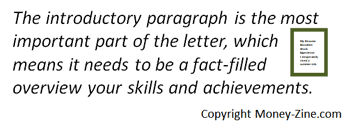Whenever completing a job application, it's important the form be accompanied by an introductory letter. The format will be very much the same as a cover letter, since both documents provide an opportunity for the applicant to summarize their talents for the reader.
Writing a Job Application Letter
Since the objective of the letter is to highlight the important information included in the job application, it's important to make sure it's concise and focused. The best way to consistently achieve that objective is to use the same format, regardless of the employer, while tailoring the letter to each position.
| Additional Resources |
| Filling Out Job Applications Job Application Forms How to Apply for a Job Writing a Letter of Resignation About Job References |
The ideal format consists of a four paragraph formula:
Introductory Paragraph
Objective Statement
Achievements
Closing Statement
Each of these sections is discussed in the paragraphs that follow, in addition to providing an example demonstrating how this information would appear in the letter.
Introductory Paragraphs
The introductory paragraph is going to be the single most important part of the letter. That means it needs to be a fact-filled overview of the skills and achievements that later appear in the application. The best way to show how this is done is through an example.
Example: Introductory Paragraph
I have effectively combined my (educational background) and skills in the areas of (marketing and operations) to successfully (meet all balanced scorecard targets) and (generate sales in excess of $5.0 million). I have been asked to take on increasingly more responsibility at Company XYZ.
Objective Statements
In the second paragraph of the letter, the job applicant needs to do something that is relatively simple, but often left out when preparing these letters: Explain to the reader why they're applying for a job at their company. The key element in this second paragraph is the objective statement, which is a summary of the job opportunities the applicant wants to pursue at the company. Once again, this statement needs to be focused. When applying for several types of jobs, the statement can be somewhat vague.

Example: Objective Statement
I am bringing to your attention my skills, accomplishments, and (talent for selling in a competitive marketplace) so that we can discuss joining XYZ Company as a (senior member of your direct sales) team.
Achievements
The third paragraph will contain a bulleted list of achievements which may be pulled directly from the job application, or can be found in the resume. Placing this important information in the letter should motivate the reader to take a closer look at the enclosed application.
Examples: Achievements
Major achievements to date include:
Founded a small business following graduation, and grew revenue over the course of eight years to nearly $3,000,000.
Significantly upgraded workforce planning process of Large Company's call center operations, resulting in a 15% increase in service level in just one year's time.
Closing Statements
The final paragraph is a simple statement of optimism. The writer wants to tell the reader they're interested in speaking with them about how they can add value to their company. The following examples demonstrate how to structure the closing statement of an application letter.
Examples: Closing Statement
I look forward to meeting with you to discuss how I can add value to your company's bottom-line results.
I am eager to discuss with you how I can help turn your company's operations around, and increase your shareholder's value.
Example Letter
Now that each section of the letter has been reviewed, it's time to see how this information fits together. The following document can be used as a guide: Job Application Letter Sample. Anyone looking for additional ideas should take a look at some of the other cover letter samples and resources this website has to offer, including:
While each of the above resources talks about cover letters, the examples provided in those documents can be easily modified to accompany job applications.
About the Author - Job Application Introductory Letters


